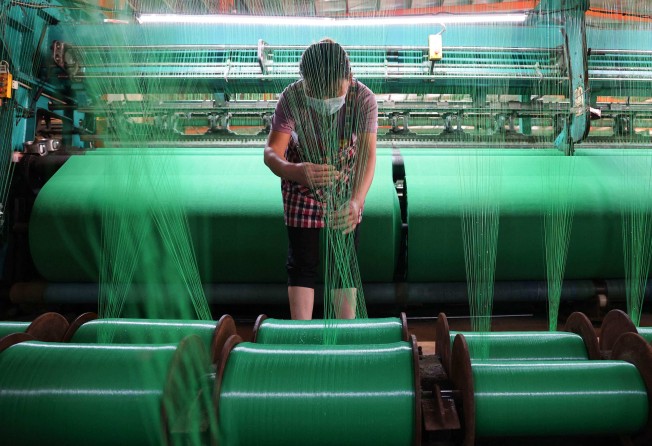China’s factory, services activity both contract in October as coronavirus curbs weigh on economy
- China’s official manufacturing purchasing managers’ index (PMI) fell to 49.2 in October from 50.1 in September
- Official non-manufacturing PMI, which measures business sentiment in the services and construction sectors, fell to 48.7 in October from 50.6 in September

Both China’s factory and services activity contracted in October, data released on Monday showed, pointing to a “further loss of momentum” as coronavirus disruptions worsened and export orders remained under pressure.
The official manufacturing purchasing managers’ index (PMI) fell to 49.2 this month, down from 50.1 in September, according to the National Bureau of Statistics (NBS). The 50-mark separates growth from contraction on a monthly basis.
The official non-manufacturing PMI, which measures business sentiment in the services and construction sectors, fell for the first time since May, dropping to 48.7 in October from 50.6 in September.
“The official PMIs point to a further loss of momentum in this month as virus disruptions worsened and export orders remained under pressure. With the zero-Covid policy here to stay, we think the economy will continue to struggle heading into 2023,” said Zichun Huang, China economist at Capital Economics.
The official composite PMI, which includes both manufacturing and services activity, fell to 49.0 in October, down from 50.9 in September.
“In terms of the non-manufacturing PMI, the index was still dragged lower by real estate and construction. But adding to the gloom, the retail sector was also weaker, even though the first week of October was the golden week holidays. As a result, we believe that retail sales in October could be very soft,” said Iris Pang, chief economist, for Greater China at ING.
“All in all, October looks to have been a weak month for the economy, and November looks as if it will be no better than October. Compounding this is the fact that Covid cases are climbing again, and it is possible that we will see further small-scale lockdowns in China. We also expect a contraction in export demand in the coming months reflecting the weakening external environment.”
In September, China’s exports fell short of expectations, growing by 5.7 per cent, compared with a year earlier, down from 7.1 per cent growth in August
Within the manufacturing PMI, the output component fell from 51.5 to 49.6 amid weakening demand, while the new orders index dropped from 49.8 to 48.1 and export orders remained weak at 47.6.
“October’s drop in the official manufacturing PMI was broad-based. Overall, four of the five sub-indices that directly feed into the headline manufacturing PMI calculation dropped in October, with all of the five sub-indices remaining in contractionary territory,” said economists from Nomura.
“Weakening external demand, worsening lockdowns and the property fallout disrupted the recovery of the previous months, and will likely exert stronger downward pressure on growth over the next couple of months.”
Last week, China confirmed its economy grew by 3.9 per cent in the third quarter, up from 0.4 per cent expansion in the second, but coronavirus restrictions, a prolonged property slump and global recession risks are weighting on the long-term outlook.
Premier Li Keqiang said that it had been “no easy feat” to ensure economic growth in the third quarter, but reiterated pledges to stabilise the economy and stimulate demand to lift growth in the final quarter of the year.
“In October, affected by the spread of the pandemic and other factors within the country, China’s PMI fell, with the manufacturing PMI, non-manufacturing PMI and comprehensive PMI standing at 49.2 per cent, 48.7 per cent and 49.0 per cent, respectively, and the foundation of China’s economic recovery needs to be further consolidated,” said senior NBS statistician Zhao Qinghe.
The International Monetary Fund and the World Bank recently slashed their 2022 growth outlook for China to 3.2 per cent and 2.8 per cent, respectively, which could be the lowest growth rates in four decades, excluding the initial coronavirus crisis in 2020.
China has set its gross domestic product (GDP) growth target for 2022 at “around 5.5 per cent”, but Li has since admitted China is likely to fall short.
We don’t expect the zero-Covid policy to be abandoned until 2024, which means virus disruptions will keep in-person services activity subdued
Economic growth in the first three quarters of the year stood at 3 per cent, missing market expectations.
“Looking forward, we think the economy will continue to struggle over the coming months. We don’t expect the zero-Covid policy to be abandoned until 2024, which means virus disruptions will keep in-person services activity subdued,” added Huang from Capital Economics.
“In addition, the deepening global downturn will continue to weigh on exporters. and officials are still struggling to put a floor underneath the property market. Concerns about the [yuan’s] weakness against the US dollar will also prevent the [People’s Bank of China] from cutting policy rates in the near-term.”